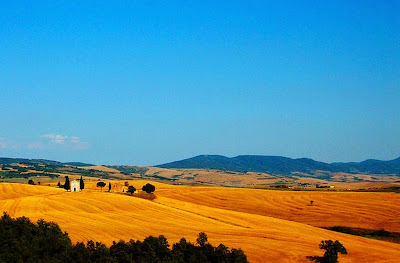My bottle of Tuscany was manufactured in June, 2011, which makes it a recent formula, although presumably not the latest and greatest. I understand this fragrance has suffered tremendously from reformulation, to the point where its fans no longer want to buy new bottles. They seek only "vintage" and say that the old stuff was much richer and ballsier in the woodsy-herbal department. I'm probably writing in error when I say this, but based on what I've read, I can't imagine the original version was a particularly interesting old-school masculine. There are only so many ways you can take citrus, lavender, "Mediterranean" herbs, patchouli, tamed floral notes, synthetic sandalwood, and synthetic musk, and make them smell unique together. Azzaro Pour Homme already has quite the little Italian sports car with that package, as does Krizia Uomo, Quorum, and the original Davidoff scent. I think Azzaro's fougère is Tuscany's main problem, and was likely the fragrance that prevented Lauder's scent from dominating its corner of the men's market at the time. As far as the success of the eighties and nineties Aramis line goes, the brand has always been the Cyndi Lauper to someone else's Madonna anyway.
Owning and wearing the current stuff with no knowledge of the original is neither here nor there to me, though. What matters to me is that the current fragrance possesses the above laundry list of typical eighties genre notes, yet somehow manages to smell unlike any other middle class designer scent I've ever worn before. I say "middle class" because Tuscany does resemble an upscale designer scent in the heart and base, but I'll get to that in a moment. First, the start of the perfume on skin - expect an Azzaro effect in those first ten minutes, but with a defter handling of the anisic citrus/lavender accord, due mainly to a more naturalistic rendition of citrus, a much subtler use of anise, and a very Moustache-like blending of lavender into the potent citrus, almost to an abstract degree. Never does the lavender leap out and smack my nose, like it does in Azzaro PH. Instead, a vibrant accord of bergamot, lemon, and lime assails me, smelling very juicy and fresh. This crisp, shimmery citrus intro remains a deciding factor for how interesting Tuscany eventually becomes. First and foremost, it is a refreshing execution of citrus rarely found in a scent of any pedigree. It smells not of cleaning agents (as an accidental over-application of Moustache might), or of extra-fine cold-pressed soap (4711), but of very real fruits blended in discreet harmony. I really admire this aspect of the scent.
Two hours later an interesting note peeks through the dusting of herbs and spices. It's a citric note with a sweetly floral edge, which creates the illusion of citrus lasting well past the top note phase. This note is very clearly neroli, with a bit of bitter orange rind sprinkled on it, and its clarity puts Tuscany squarely beside Creed's Orange Spice for the remainder of its drydown. I feel no qualms in saying that the materials used for this floral accord are the exact same materials used in Orange Spice, only here they're used in a much lower concentration. There's just enough anise, patchouli, and zesty caraway to maintain complexity and herbal texture, yet Tuscany carries itself as a bracing citrus composition (perhaps with a drop of Hedione in the mix) for five hours before fading away to a skin musk. To design Tuscany as a citrus fougère makes perfect sense from a conceptual standpoint. I attended college in Italy in 2004, visited Tuscany, and stayed for a few nights in Florence. The Tuscan region is not known for growing oranges, except the bitter Chinotto orange, yet it is home to a slew of local recipes that feature the fruit in various salads, pastries, and even French-derived duck dishes. Funnily enough, Italian Fanta (the soda) is in my experience the fruitiest and most citric version available in mainland Europe, and is far superior to French, German, Czech, Irish, and English Fanta. And there's always Limoncello. Even in crap beverages, the Italians take citrus seriously.
Lauder is not an Italian brand, and the minds behind this perfume had no vested interest in being truly representative of the region, but it is a very well made EDT with a sublime citrus component, making it a desirable addition to the collection of any lover of twentieth century fougères. If you enjoy Azzaro PH but always wished its relatively harsh citrus and lavender notes were better calibrated, Tuscany is for you. I suppose seeking out the original formula is a worthy pursuit if you're interested in richer patchouli and sandalwood notes, provided its naturals and synthetics survived the decades intact. Just keep in mind that the wonderful citrus notes are not likely to have made it through thirty years unscathed. If my description of this perfume intrigues you more, then purchase Azzaro PH for your woodier fern variant on this theme, and go for the recent version of Tuscany for a brighter, fresher take on the Italianate fougère. My experience with the Aramis line is currently limited to the original Aramis and Tuscany, but now that I've worn the latter scent, I seriously want to give Havana, JHL, and New West a try also.




